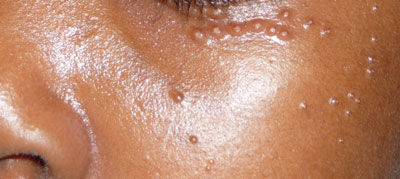By: Deepti Gupta, MD, FAAD, FAAP & Matthew Mahoney, DO
Molluscum contagiosum, or molluscum for short, is a common skin infection in children. It is caused by a poxvirus, called molluscum virus. The infection leads to harmless small, skin-colored bumps in the skin's top layers. Most often, molluscum eventually clears up on its own without medical treatment.
How do you get molluscum?
The virus that causes molluscum is spread mostly by skin-to-skin contact. However, the virus can also spread on things like towels, bedding or shared athletic equipment. The bumps seen with molluscum usually appear two to six weeks after the skin has been exposed to the virus.
What are the signs & symptoms of molluscum?
 Molluscum causes small, round (usually less than ¼ inch) raised bumps (also called papules) on the skin. They are usually skin-colored or pinkish with a shiny surface. They often have a small indent or dot near the center of the bump.
Molluscum causes small, round (usually less than ¼ inch) raised bumps (also called papules) on the skin. They are usually skin-colored or pinkish with a shiny surface. They often have a small indent or dot near the center of the bump.
Molluscum bumps are found most often on the body, arms and legs, but may show up anywhere including the face and groin. They often cluster in areas where the skin touches, like the armpits, elbow fold and behind the knees. The bumps can be itchy, but aren't usually painful. When the molluscum bumps go away they can sometimes leave behind small "pock marks" or pinpoint pits.
How do we treat molluscum?
Most children with molluscum do not need treatment. Without treatment, the bumps will usually disappear within 6 months to 2 years on their own.
 There are treatment options if the molluscum bumps are bothersome in how they look or feel, or when there is concern about their spread to others.
There are treatment options if the molluscum bumps are bothersome in how they look or feel, or when there is concern about their spread to others.
Some treatment options for molluscum include freezing the bumps (called cryotherapy), scraping off the bumps (called curettage), or using chemicals to make the body fight them faster (called cantharidin solution or berdazimer gel). Other products can be used on the skin to irritate the molluscum bumps to get the body's immune system to recognize them, but these have mixed results.
Some of these methods can be painful and in rare cases, can lead to scarring or changes in the skin color after the molluscum bumps have healed.
What if the molluscum bumps hurt?
Sometimes, molluscum bumps can become enlarged, red and sore before they start to go away. If that happens, warm compresses can help. To make a warm compress, you can soak a clean washcloth under warm running water. Squeeze out excess water and place it on the painful bumps for 10 minutes.
If there is a spreading red patch around a bump, contact your child's doctor.
How do you prevent molluscum?
As with most types of infection, washing hands often is most important. It also helps to avoid sharing towels, clothing and personal items. Individuals affected by molluscum should cover the bumps that aren't under clothing and that might easily come in contact with others.
Remember
Molluscum infection is common and can be a bother, but the bumps aren't dangerous and gradually clear on their own. Your child's doctor can provide more guidance and advice if the bumps are causing you or your child concern.
More information
About Dr. Gupta
 Deepti Gupta, MD, FAAD, FAAP is pediatric dermatologist practicing at Seattle Children's Hospital. She is triple board-certified in Pediatrics, Dermatology, and Pediatric Dermatology. She is a member of the American Academy of Pediatrics Section on Dermatology Executive Board and Education Committee. Deepti Gupta, MD, FAAD, FAAP is pediatric dermatologist practicing at Seattle Children's Hospital. She is triple board-certified in Pediatrics, Dermatology, and Pediatric Dermatology. She is a member of the American Academy of Pediatrics Section on Dermatology Executive Board and Education Committee.
|
About Dr. Mahoney
 Matthew Mahoney, DO is a pediatric resident physician at the University of Minnesota and M Health Fairview Masonic Children's Hospital. He has a special interest in pediatric dermatology and is a member of the American Academy of Pediatrics Section on Dermatology Education Committee. Matthew Mahoney, DO is a pediatric resident physician at the University of Minnesota and M Health Fairview Masonic Children's Hospital. He has a special interest in pediatric dermatology and is a member of the American Academy of Pediatrics Section on Dermatology Education Committee.
|
Images of molluscum on face and neck courtesy Sarah Stein, MD, FAAD, FAAP